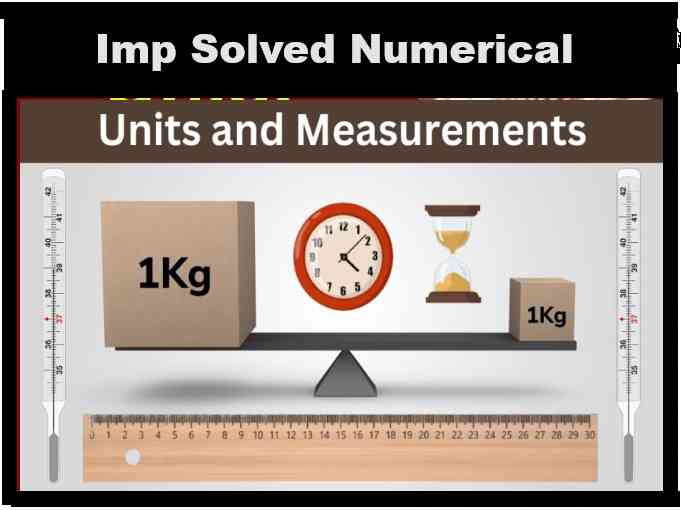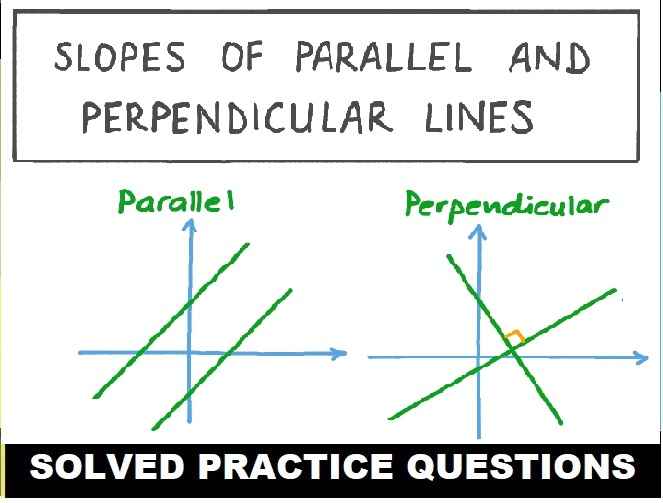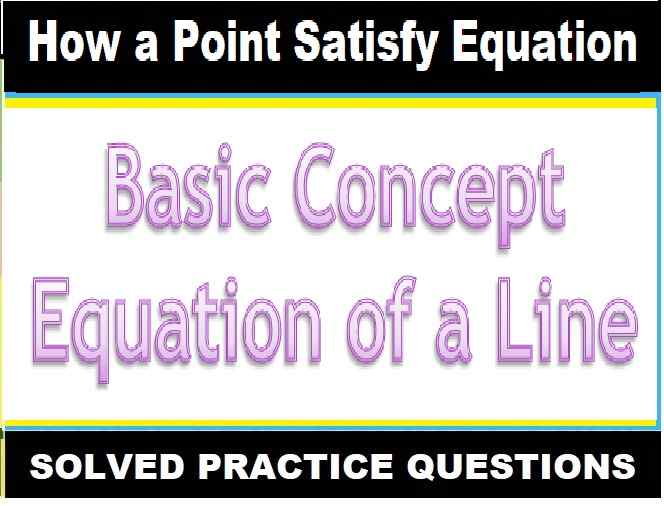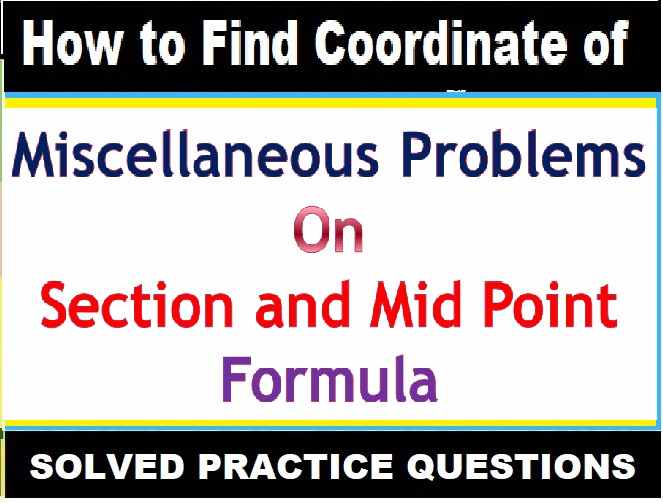Units and Measurements Numerical Class 11 Physics ISC Nootan Solutions Ch-2. Step by step solutions of Kumar and Mittal Physics of Nageen Prakashan as council latest prescribe guideline for upcoming exam. Visit official Website CISCE for detail information about ISC Board Class-11 Physics.

Units and Measurements Numerical Class 11 Physics ISC Nootan Solutions Ch-2
| Board | ISC |
| Class | 11 |
| Subject | Physics |
| Book | Nootan |
| Chapter-2 | Units and Measurements: Error Analysis and Significant Figures |
| Topics | Numericals on Units and Measurements |
| Academic Session | 2024-2025 |
Numericals on Units and Measurements
(Units and Measurements Numerical Class 11 Physics ISC Nootan Solutions Ch-2)
Que-1: The mean wavelength of yellow light from a sodium lamp is 5893 Å. Write it in m and nm.
Sol: We have given, the wavelength of the yellow light:
λ = 5893 Å
Convert unit of wavelength from Å to meters:
We know that 1 Å = 10⁻¹⁰m
Therefore, the wavelength, λ = 5893 × 10⁻¹⁰m
Now, to express the wavelength in nanometres,
We know that, 1nm = 10⁻⁹m
⇒ 1m = 10⁹nm
Therefore, the wavelength, λ = 5893 × 10⁻¹⁰ × 10⁹nm
λ = 5893 × 10⁻¹nm
λ = 589.3nm
Therefore, the yellow light of wavelength 5893Å is equal to 589.3 nm.
Que-2: Calculate the number of metric tons in a teragram.
Sol: 1 teregram = 10^12
1 metric ton = 10^3 kg = 10^6 gm
1 tergram / 1 metric ton = (10^12) / 10^6 gm
= 10^6 gm ans
Que-3: The mass of a proton is 1.67× 10^-27 kg. How many protons would make 1g? Express in order of magnitude also.
Sol: mass of proton=1.67*10^-27kg
=1.67*10^-24g
therefore, 1 proton= 1.67*10^-24g
1g = 1/1.67*10^-24
1g=0.5988*10^24
1g=5.988*10^23
therefore, no of proton in 1 g =5.99*10^23 proton.
In order of magnitude it has 10^24.
Que-4: Find the number of hydrogen atom required to obtain 1.0 kg of hydrogen. Take the mass of one hydrogen atom to be 1.0 u. Given : 1.0 u = 1.66*10^-27kg.
Sol: Mass of Hydrogen to be obtained-1kg = l000g
Mass of one hydrogen atom = 1u = 1.66×10^-27 kg = 1.66×10^-24g
No of atoms in 1000g of Hydrogen = 1000/1.66×10^-24 = 6.02×10^26 Ans.
Que-5: The earth has a mass of 5.98*10^24kg.The average mass of the atoms of earth is 40u.How many atoms are in the earths?
Sol: Number of atom in earth, n = total mass of earth (M) / mass of each atom (m)
n = m/M
= (5.98×10^24) / (40×1.66×10^-27)
= 9×10^49 Ans.
Que-6: The density of water of 4°C is 1.0 g cm^-3. Find its value in SI.
Sol: Density, d1g/cm³
1g = 103 kg -3
1cm³ = (102m)³ = 10-6m³
d’ = 1(103 kg) (10-6m³) = 1.00*10^3 kg/m³ Ans.
Que-7: The acceleration of a body is 10ms^-2. Express it in km h^2.
Sol: a = 10 m/(1s)²
= 10×10¯³ km / (1/(60x60h))²
= (3600)² x 10‾² km/h²
= 1.296 x 10^5 km/h² Ans.
Que-8: The value of universal gravitation constant G=6.67*10^-11 nm^2 kg^-2. Find its value in g¯¹ cm³ s¯².
Sol: G = 6.67 × 10-11 N m2 kg-2
Given, 1 N = 1 kg m s-2
Now, G = 6.67 × 10-11 × kg m s-2 × m2 kg-2
= 6.67 × 10-11 × kg-1 m3 s-2
= 6.67 × 10^-11 m^3 /kg s^2 …….. (i)
1 kg = 1000 g = 103 g
1 m = 100 cm = 102 cm
Now putting these values in equation (i)
= 6.67 × 10-11 (10^2 cm)^3/ 10^3 g s ^2
= 6.67 × 10-11 10^6 cm^3/10^3g s^2.
= 6.67 × 10-11 × 103 g-1 cm3 s-2
= 6.67 × 10-8 g-1 cm3 s-2
Que-9: The value of Stefan’s constant σ = 5.67*10^-5 erg s^-1 cm^-1 K^-4. Find its value in SI. Given 1J=10^7 kg.
Sol: C.G.S units: σ= 5.67 x 10⁻⁵ erg/s cm² K⁴
S.I UNIT CONVERSIONS :1J=10⁷ ergs
1erg=10⁻⁷J
1m=100cm
1m²=10000cm²
1cm²=10⁻⁴ m²
σ = 5.67 x10⁻⁵ x 10⁻⁷J/s 10⁻⁴m² K⁴
σ = 5.67 x 10⁻⁵ x 10⁻³W m⁻² K⁻⁴
since 1 W =1J/S
∴σ=5.67 x 10⁻⁸ W m⁻² K⁻⁴
Que-10: Express the speed of light (=3.0*10^8 m/s) in term of AU/min.
Sol: Speed of the light C = 3*10^8 m/s
= 3*10^8 [10-3 Km/0.01666 min] =3*10^8 [10-3 (1.50*10^8) -1 AU/0.016666 min] =120*10^-3
= 0.12 AU/min Ans.
Que-11: If the speed of light is the new unit of speed and year the new unit of time , then what will be the new unit of length? What is its name? Given: c=3*10^8 m s^-1 and 1 year = 3.154*10^7 sec.
Sol: 1 unit velocity of light = 1 unit length and 1 unit time
1 unit length = 1 unit velocity of light x I unit time
3×10^8×365×24×60×60
94608000×10^8
9.4608×10^15 m Ans.
So, it is 1 light year.
Que-12: For a new unit of length, the speed of radio wave is unity. Find the distance of a aircraft from a RADAR, if the radio signal returns back after reflection from the aircraft in 8.4 μs.
Sol: Speed of radio wave = 3×10 m/sec
distance = (Speed x time)/2
because wave returns offer refection.
3 x 10 x 8.4 x 106
2 4.2x106x(3×108) new und
distance = 4.2×10^-6 new unit Ans.
Que-13: Express the number of seconds in a day and in a year in order of magnitude.
Sol: Seconds in a day=24*60*60 =24*3600 =86400 =8.64 * 104s
Order of magnitude = 105s Ans.
(1 year) =365 days
hours days =3600 seconds hours
= (365) (24) (3600 seconds)
=3153600
=3.1536×107 sec
Therefore, the order of magnitude of a year is 107 s Ans.
Que-14: The number of protons and neutrons in the universe is of the order of 10^82 and that in the sun is of the order of 10^57. If we assume that all stars are of the same mass of sun, then what would be the order of the number of stars in the universe?
Sol: Order of number of neutrons and protons in the universe = 1082
Order of number of neutrons and protons in Sun = 1057
If we assume Sun and stars are made up of mainly protons and neutrons
and mass of sun and stars are nearly equal , then order of number of stars is given as
Order of number of stars = ( 1082 / 1057 ) = 1025
Que-15: If an atom ( size=10^-10m) were enlarged to the size of earth (= 10^7 m ), how large would its nucleus (=10^-15 m ) be?
Sol: Size of the nucleus / size of the atom
= x/10^7 = 10^-5 / 10^-10
= 10^-10 x = 10^-8 = 10² m Ans.
Que-16: If the universe (=10^26 m) were to sink to the size of earth (=10^7 m), how large would the earth be?
Sol: The size of the universe = 10^{26} m
The size of the earth = 10^{7} m
We use the formula,
Magnification = Size of earth / Size of universe
= 10^{7} / 10^{26}
= 10^{-19} m.
The actual size of the earth = 10^{7} m
The apparent size of the earth = M × 10^{7} = 10^{-19} × 10^{7} = 10^{-12} m.
Que-17: The heart beats once in 0.8s. Find the number of times the heart beat in the life of 60 years of a man.
Sol: In 0.8 s, the human heart makes one beat.
In 1 s the human heart makes
1/0.8 = 10/8 beats.
.. In 50 years the human heart makes -10/8 x 50 x 365 x 24 x 60 x 60 beats
= 2.37x 10^9 beats. Ans.
— : end of Numerical on Units and Measurements for Class 11 Physics :–
Return to : – Nootan Solutions for ISC Class-11 Physics
Thanks
Please share with your friends


